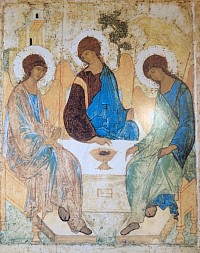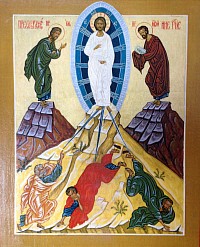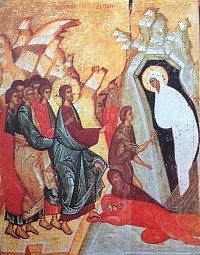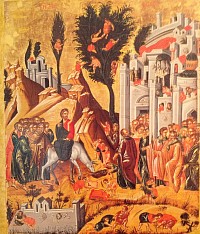Gallery
Many visitors have wanted to know who are the ikons represented on the walls of our church. This gallery explains who they are, explains a little of their history, and tries to convey that these were at one time, very real and living people who lived, breathed, had good days and bad days, had fathers and mothers and whose relationship with God was such that they offer a model for the rest of us. As far as possible, this gallery is arranged chronologically.
It would be easy for the non Orthodox to think that the vision Orthodox Christians had of the saints was only one of sycophantic blind acceptance of things we neither know nor understand. I want to stress that this is far from the case, but the reason we surround ourselves with the memory of these people is that they speak to us of God in ways that can deepen our own understanding of God. In the same way that Shakespeare speaks so profoundly of the human condition, if we are prepared to listen, the saints speak to us of the potential that the human relationship can have if we listen to God.
Ikons are opportunities God puts in our way to open a window into the eternal dimension. By taking the opportunity to pause before and ikon, we can remove ourselves from the present moment, from what we have been doing and what we will be doing, to focus on the presence of God, His angels and His saints. Ikons are a conduit through which we remind ourselves of how the ordinary became holy. How an ordinary day became transformed by God's miracle. How an ordinary person became so close to God they became extraordinary, and how by momentarily attaching ourselves to either miracles, the miraculous or the devoted to God, we can glimpse some of that special moment for ourselves.
Praying before an ikon, or a collection of ikons as one does with a domestic ikon corner, is to be as part of a crowd of people who love God and who will love God eternally. There is some real comfort in knowing you are not alone in your love of God, and by taking your place alongside others, through this window of ikons, you stand in the company of saints and angels before God to petition, adore, or simply 'be'.
The Trinity
This ikon of the Trinity is a reproduction of one painted around 1410 by Andrei Rublev. It depicts the three angels who visited Abraham at the Oak of Mamre – but is often interpreted as an ikon of the Trinity. It is sometimes called the ikon of the Old Testament Trinity. The image is full of symbolism – designed to take the viewer into the Mystery of the Trinity.
The Annunciation
The Annunciation is the story the church uses to describe how Mary was told she would be unaccountably pregnant. Joseph and Mary had gone through a ceremony at their local synagogue so their community would know that they intended to marry.
This betrothal service meant that although neither was yet married to the other, Joseph couldn't consider another girl and no other man could cast an eye at Mary. Betrothal and marriage in those days should be thought of as civil ceremonies, with the (civil) law being Jewish law. Joseph and Mary may well have announced their betrothal "in the city gates" before the elders of the village. Betrothal was as binding as marriage and required a divorce decree to dissolve it; after the betrothal the couple were not permitted intercourse until the marriage. In traditional Orthodox belief, Mary in practice remained "ever virgin" even after the marriage took place, but in reality she was unlikely to have been a virgin sexually. The accounts that James was also her son are credible, and many believe that Joseph was in fact the biological father of Jesus, and the intervention of the Holy Spirit took place in utero after the event, with the event all being part of Divine intervention. For Mary to have conceived virginally throws into question the nature of Jesus being of the Davidic line, because under Jewish law the Messiach had to come down the paternal line, not the maternal, and to be the Messiach Joseph would therefore have to be the father. The virginal component of the gospel narrative, written many years post crucifixion, was probably written to match prophetic literature to the birth, rather than being an historical account. This isn't the traditional Orthodox view, but is one that reflects a more rational perspective. Traditional Orthodoxy holds that she was sexually intact, ludicrous as that may seem historically. If Mary was a virgin Jesus can't be the Messiach, the two are mutually incompatible.
The Nativity of Christ
In Orthodoxy, 'Theotokos' is the title given to Mary, and it means "Bearer" or "birth-giver' of God. The Orthodox church also refers to her as the 'Mother of God' (a title that stresses the divine nature of her son, Jesus) as well as 'the virgin Mary'. In Orthodoxy, Mary is elevated to a special place in the account of Jesus' life, and it is often stressed that it was only her consent to what was announced to her by the Archangel Gabriel that made Jesus' life and ministry possible. She is honoured in every service, and the Orthodox church marks also certain festivals (not only the Nativity of her son) that recount events in her life. Some of these 'events' are recorded not in the gospels themselves but in the Tradition that has been handed down, and these accounts are to be understood, not as accurately reflecting her history, but rather as conveying to us her importance in God's plan of salvation.
This ikon, like some others, depicts a number of related events and not just one particular point in time. Thus, for example, we see Mary and Joseph travelling towards Bethlehem before Jesus' birth as well as events that occurred after his birth.
Presentation in the Temple
The feast of the Presentation of Jesus at the Temple falls on 2nd February, and celebrates an early episode in the life of Jesus. According to Jewish tradition and practice, firstborn male children had to be taken to the Temple and a sacrifice offered as laid out in Exodus. Joseph and Mary were devout Jews, as was Jesus, and the Law had to be fulfilled.
It was at this event that Simeon, who had been promised by God that he wouldn't die until he had seen the Jewish Messiah, took Jesus into his arms and said, "Now Lord let your servant depart in peace, for I have seen Your salvation. A light to enlighten the Gentiles, and the glory of Your people Israel".
The Baptism in the Jordan
The Baptism by John of Jesus in the Jordan is widely accepted by scholars as an historically accurate event. It either took place, it is believed, at Bethabera in Perea, or Enon near Salim. Rivers can be - and still are - used for Mikvehs - the water for ritual immersion has to be either rainwater or running water such as in a river. Men also went to the Mikveh, to be cleansed of ritual impurity such as that contracted by contact with a corpse. Many Orthodox men today will go to the Mikveh every Friday, before Shabbat, so they will be both physically and spiritually clean before the Sabbath. One must bathe, including washing one's hair, before entering the Mikveh. Any parts of the body "covered" by dirt are not considered to have come into contact with the "living" water of the Mikveh, thus nullifying the purification.
Baptism (a Greek word meaning 'washing') is a form of ritual washing that is a continuation of the ritual cleansing laid down in the Torah. The Torah required washing for a variety of reasons and occasions. Washing of utensils, the washing of the body, and the washing in a Mikvah after women had their period are all part of ancient Jewish life, and in many cases, modern Jewish life. One of these ritual washings were for those who wanted to convert to Judaism, marking the end of one life and the beginning of another with the washing away of the old life and renewal in the new.
Throughout his life, John sought to turn Jews from their old life which had become distant from God and to bring them through repentance to a renewed relationship with God. Jesus did the same. He continually sought to bring people back to God, from whom they had strayed. But to understand the significance of the baptism, which Orthodoxy sees as the start of Jesus ministry, one needs to look 200 years beforehand.
At that time there were three main strands which influenced Jewish thinking, and, of course, the thinking and experiences behind the ministries of both John and Jesus. The Pharisees (the ancestors of today's Judaism), the Sadducees (the Temple priesthood) and the Essenes (meaning 'pious ones'). The Essenes were probably an offshoot of the Pharisaical school, but took a rather rigid adherence to the Law to bring them closer to God. The Sadducees, who disappeared around AD 70 after the destruction of the Temple, didn't believe in an afterlife, while Essenes and Pharisees did. While the Essenes and the Pharisees were focused on the letter of the Law, Jesus wanted to bring people awake to the spirit of the Law.
One branch of the Essenes organised themselves into fraternities, praying together, worshipping together in their homes, and eating communal meals together. Some scholars have suggested that Jesus, when he gathered the apostles and disciples into His own fraternity, was influenced by this example, and that as a result the early church had very similar beliefs in certain respects. Other scholars have seen John the Baptist in a similar light.
The Transfiguration
The Transfiguration of Christ is one of the Great Feasts of the Orthodox Church and is celebrated on August 6th each year.
It commemorates the event, described in the gospels, when Jesus had gone with his disciples Peter, James and John to Mount Tabor. Christ's appearance was changed while they watched, into a glorious radiant figure. There appeared Elijah and Moses speaking with Jesus (though we are not told how Moses and Elijah were recognised as no images of either were known then or now). The account describes the Transfiguration close to the Passover, but given that the disciples offered to build Tabernacles for the three it could be believed that Christ's transfiguration took place at the time of the Jewish Festival of Tabernacles (harvest time around autumn), and that the celebration of the event in the Christian Church became the New Testament fulfillment of the Old Testament feast. The Orthodox Church connects these two feasts to help Christians understand the mission of Christ and that his suffering was voluntary.
Raising of Lazarus
Lazarus and his sisters are family friends and while Jesus is in the area of His baptism, he gets a message that Lazarus is ill. Jesus delays going there convinced that by so doing He will be able to do something even more remarkable than by heading death off at the Pass. Four days after Lazarus dies Jesus turns up at Bethany near Jerusalem on the Jericho road. According to custom and Law, Lazarus is already entombed. Jesus states that the stone should be removed from the tomb entrance. Quite reasonably Martha objects. Lazarus, remember, had been sick for a long time, in an age without antibiotics. The death, we are told, is related to disease and not a fracture, thus we can reasonably ascertain that decay was long advanced before Lazarus died, never mind the extent of decay in the heat of a Middle Eastern sun four days post mortality. The anticipated whiff of putrefaction must have been terrifying. Following Jesus shouting for Lazarus to come out, Lazarus emerges, oil embalmed, cloth bound, shuffling and staggering into the sunlight.
Christ enters Jerusalem
Whilst Jesus regularly went to Jerusalem to teach and attend the Temple, all four gospels record Jesus arriving at Jerusalem on a donkey in order to celebrate the Passover, when the Israelites were spared the Angel of Death by marking on their door lintels the blood of a lamb. This took place in the month of Nisan (around March - April), a month during which many momentous events in Jewish history have taken place Recent studies have suggested March 30th AD 33 as the probable date.
During the Passover, animals were donated to the Temple free for use by any holy man in service to God. They were gifts made as part of a mitzvah (something done freely for the benefit of others that would bring the giver closer to God). Thus, whenever any man was seen riding just such one of these donkeys during the Passover they would be recognised by the crowd as an important and holy person.
Five days before the Passover began (a Monday) Jesus sent disciples to fetch one of these animals and as He rode into Jerusalem He was welcomed by crowds waving Palm branches and spreading clothing in His path. Palm branches represented both joy and triumph to Israelis at the time, and the practice of laying clothes in the path was one afforded to kings. Jesus was recognised as the one Who had brought back Lazarus from death and as such enormous expectations were held of Him by the Israelis. This excitement was viewed rather dimly by the Pharisees and Sadducees as their own influence and power over devout Jews was diminishing before their eyes, an opinion confirmed by what happened when Jesus arrived at the Temple.
To fulfill the requirements of Passover, strict rules are laid out for the cleansing not only of houses but also of the Temple. Over time, trading in the Temple had evolved to include not only legitimate businesses selling livestock for sacrifice (lambs doves etc) but also traders selling stolen shoddy and second hand goods. The equivalent would be a car boot sale taking place in St Peter's Basilica! It was rage at this that sent Jesus trashing the stalls holders in the Temple.
After this Jesus left Jerusalem and made His way to Bethany, a suburb of Jerusalem where archeology has found that it was populated heavily by Essenes, a community to which Jesus has been frequently linked, where He remained to hold the Last Supper which was, according to some scholars, possibly a Seder. Some say that it was common at the time for Seders to take place over a period of days rather than on one particular day, and the Last Supper is held to have taken place on the Wednesday. Others confidently say that this would have taken place on just one day, 15th Nisan, in accordance with the day set out by the Torah. The Talmud relates that one of the recurring miracles was that everyone had room to prostrate themselves on Yom Kippur when the High Priest pronounced the Name of God, even though there was barely enough room for everyone to stand. The Temple had very strict rules as to how people entered and left the Temple on Pesach, and how many were let in at a time, so that everyone could sacrifice their lambs in the Temple courtyard on the afternoon of the 14th, as required by law, without any crushes occurring. It is estimated that perhaps as many as a million people were in Jerusalem during Pesach, Shavuos and Succos.








